|
Featured picture tools: |
These featured pictures, as scheduled below, appeared as the picture of the day (POTD) on the English Wikipedia's Main Page in May 2018. Individual sections for each day on this page can be linked to with the day number as the anchor name (e.g. [[Wikipedia:Picture of the day/May 2018#1]] for May 1).
You can add an automatically updating POTD template to your user page using {{Pic of the day}} (version with blurb) or {{POTD}} (version without blurb). For instructions on how to make custom POTD layouts, see Wikipedia:Picture of the day.Purge server cache
May 1

|
The inaugural flight of Soyuz at the Guiana Space Centre, with two Galileo navigation system satellites, on 21 October 2011. In this ongoing ESA programme, Soyuz-ST launch vehicles are operated from Guiana Space Centre, providing Arianespace with a medium-size launch capability alternative to the light Vega and the heavy-lift Ariane 5. Since 2011, the programme has completed 18 missions, with another three scheduled for 2018. Photograph: DLR German Aerospace Center
Recently featured:
|
May 2

|
Antonie Frederik Jan Floris Jacob van Omphal (1788–1863) was a Dutch lieutenant general and extraordinary aide-de-camp to William III of the Netherlands. He fought in Napoleon's Imperial Guard in the Battle of Leipzig and the invasion of Russia, then under the United Kingdom of the Netherlands in the Battle of Waterloo. He was awarded a knighthood in the Military Order of William, among other honors. Painting: Herman Antonie de Bloeme
Recently featured:
|
May 3

|
The Lute Player is a painting completed by Orazio Gentileschi c. 1612–1615. It depicts a young woman in a golden dress with a lute, turned away from the observer, concentrating her attention on the nineteen-stringed instrument and listening intently to a note. The work, which exhibits influences from Caravaggio, has been variously identified as a genre painting, an allegory of hearing, and as a portrait of the goddess Harmonia. The Lute Player is now held at the National Gallery of Art in Washington, D.C. Painting: Orazio Gentileschi |
May 4

|
Mike Dirnt (b. 1972) is an American musician, songwriter and composer. He is best known as the co-founder, bassist, backing and occasional lead vocalist of American punk rock band Green Day. He has played in several other bands, including The Frustrators. Photograph: Sven-Sebastian Sajak |
May 5
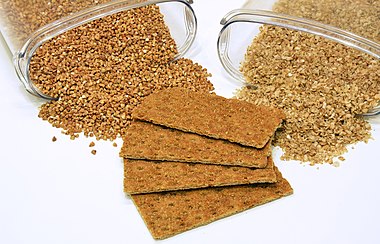
|
Buckwheat (left), shown with buckwheat flakes (right) and crispbread made of buckwheat flour (center). It may also be made into such foods as noodles, porridge, pancakes, and beer. A pseudocereal related to rhubarb, buckwheat was widely cultivated as a cover crop until the adoption of nitrogen fertilizer. Photograph: Andrey Korzun
Recently featured:
|
May 6

|
An ultraviolet image of the Cygnus Loop, a large supernova remnant in the constellation Cygnus. Different parts of the loop emit electromagnetic radiation in different ranges, including visible light for the arcs known collectively as the Veil Nebula. The complete loop is only revealed through radio, infrared, and X-ray images.
Recently featured:
|
May 7

|
I am Half-Sick of Shadows, said the Lady of Shalott is an oil painting on canvas completed by John William Waterhouse in 1915. One of three works inspired by Lord Tennyson's poem "The Lady of Shalott", it depicts the ballad's titular character as she stops weaving, shortly before looking directly upon the world outside her window for the first time. The painting is now held at the Art Gallery of Ontario in Toronto. Painting: John William Waterhouse
Recently featured:
|
May 8

|
An early example of high-dynamic-range imaging, captured by Gustave Le Gray in 1854. For this image, which was impossible at the time using standard methods owing to the extreme luminosity range, Le Gray combined one exposure for the sky and another longer one for the sea. Today, photographs with high dynamic range are primarily produced through computer renderings or merging multiple low-dynamic-range images; special image sensors, such as an oversampled binary image sensor, may also be used. Photograph: Gustave Le Gray
Recently featured:
|
May 9

|
Framing is the fitting together of pieces to give a structure support and shape during the process of construction. Framing materials are usually wood, engineered wood, or structural steel. Building framing is divided into two broad categories: heavy-frame construction, where vertical supports are few and heavy, and light-frame construction, where supports are numerous and smaller. Support may be provided through rigid panels or diagonal bracing. Shown here is the framing of a home in Sabah, Malaysia. Photograph: Uwe Aranas |
May 10

|
Condom Cathedral is a Catholic church and a national monument of France, located in Condom, Gers. Erected between 1506 and 1531, the Gothic church served as the seat of the Bishops of Condom until the diocese was added to the Archdiocese of Auch in 1822. Photograph: Benh Lieu Song |
May 11

|
Spring Scattering Stars is a 1927 painting by American artist Edwin Blashfield. It is an allegory of spring in which a nude female representing spring stands on a wet moon scattering stars throughout the sky. The painting is catalogued in the Robert Funk Inventory. Painting: Edwin Blashfield
Recently featured:
|
May 12

|
The Lady with the Lamp, a c. 1880s lithograph after Henrietta Rae depicting Florence Nightingale at a patient's bedside during the Crimean War. During the war, Nightingale (1820–1910) organised the tending to wounded soldiers, and became iconic in Victorian culture as "The Lady with the Lamp". In 1860, Nightingale laid the foundation of professional nursing with the establishment of her nursing school at St Thomas' Hospital in London. She has been recognised as the founder of modern nursing, and the pledge taken by new nurses and the highest international distinction a nurse can achieve were named in her honour. Painting: Henrietta Rae
Recently featured:
|
May 13

|
Taraxacum officinale is a flowering herbaceous perennial plant of the family Asteraceae (Compositae). Commonly known as the dandelion, it can be found growing in temperate regions of the world, in lawns, on roadsides, on disturbed banks and shores of waterways, and other areas with moist soils. Although widely considered a weed, especially in lawns and along roadsides, it is sometimes used as a medical herb and in food preparation. The species is well known for its yellow flower heads that turn into round balls of silver tufted fruits that disperse in the wind. Photograph: Petar Milošević
Recently featured:
|
May 14

|
Luidia senegalensis is a tropical species of starfish in the family Luidiidae. It has nine long, slim tapering arms attached to a small circular central disc and grows to a diameter of about 30 to 40 centimetres (12 to 16 in). It can be found from the coasts of Florida as far south as southern Brazil, where it favours sandy, muddy or shelly seabeds in sheltered locations such as lagoons. It feeds primarily on molluscs, small crustaceans, and polychaete worms, which it swallows whole by everting its stomach and engulfing its prey. Photograph: Andrea Westmoreland
Recently featured:
|
May 15

|
The Gillette Mach3 is a line of safety razors produced by Gillette beginning in 1998. The three-blade design is marketed as allowing for shavers to use less pressure and fewer strokes, reducing skin irritation. Several models are based on this design, including the Mach3 line for men and the Venus line for women. Photograph: Chris Woodrich
Recently featured:
|
May 16
Subpage 1

|
Madonna is a title given to a composition by the Norwegian expressionist painter Edvard Munch. He painted several versions of the composition between 1892 and 1895, using oils on canvas as well as lithography. Several interpretations of the bare-breasted half-length female figure have been offered, including that she represents the Virgin Mary, a femme fatale figure, or a paradox of "sensuality shot through with imagery of death and corruption". Shown here is an 1894 version of Madonna in oil, held by the Munch Museum in Oslo. See a version in lithography Painting: Edvard Munch
Recently featured:
|
Subpage 2

|
Madonna is a title given to a composition by the Norwegian expressionist painter Edvard Munch. He painted several versions of the composition between 1892 and 1895, using oils on canvas as well as lithography. Several interpretations of the bare-breasted half-length female figure have been offered, including that she represents the Virgin Mary, a femme fatale figure, or a paradox of "sensuality shot through with imagery of death and corruption". Shown here is a c. 1895–1902 version of Madonna in lithography, held by the Ohara Museum of Art in Kurashiki, Japan. See a version in oil Painting: Edvard Munch
Recently featured:
|
May 17

|
The Assut de l'Or Bridge is a white single-pylon cable-stayed bridge in the City of Arts and Sciences, Valencia, Spain. Completed in 2008, it was designed by Valencian architect and civil engineer Santiago Calatrava as a variant of his cantilever spar cable-stayed bridge in Seville. Photograph: Diego Delso
Recently featured:
|
May 18

|
A German ostmark banknote issued by the German Empire towards the end of World War I, for circulation in the "Upper East" region of occupied territories. Issued by the State Loan Bank in Kowno, Lithuania, this currency was equivalent to the German Papiermark and denominated from ½ Mark through 1000 Marks. It remained in use in Lithuania until 1922, when it was replaced by the litas. Banknote: State Loan Bank (image courtesy of the National Numismatic Collection, National Museum of American History)
Recently featured:
|
May 19

|
Portrait of Antoine-Laurent Lavoisier and his Wife is a double portrait of the French chemist Antoine Lavoisier and his wife and collaborator Marie-Anne. Commissioned from the French painter Jacques-Louis David in 1788 for 7,000 livres, the portrait remained in the family until 1924, when it was acquired by John D. Rockefeller. Since 1977, it has been held by the Metropolitan Museum of Art in New York. Painting: Jacques-Louis David
Recently featured:
|
May 20

|
The Sky Garden is an interior roof garden that occupies the 34th to 37th floors of 20 Fenchurch Street, London. Called London's highest public park, it includes a large viewing area, terrace, bar and two restaurants. However, it has drawn criticism for its limited greenery. Photograph: Colin
Recently featured:
|
May 21

|
A map of Iran and Turan at the time of the Qajar dynasty, as drawn by Adolf Stieler and published in the 1891 edition of Stielers Handatlas. Published by Justus Perthes, this was the leading German world atlas of the last three decades of the 19th and the first half of the 20th century. It went through ten editions from 1816 to 1944, with the 8th edition (1888–1891) containing 95 maps. Map: Adolf Stieler |
May 22

|
The European robin (Erithacus rubecula) is a small insectivorous passerine bird. Formerly classified as a member of the thrush family, it is now considered to be an Old World flycatcher. About 12.5–14.0 cm (5.0–5.5 inch) in length, males and females are similar in colouration, with an orange breast and face lined with grey, brown upperparts and a whitish belly; the orange breast emerges gradually after birth, as with the juvenile specimen shown here. The species is found across Europe, east to Western Siberia and south to North Africa; it is sedentary in most of its range except the far north. The unrelated American robin was named after it. Photograph: Charles J. Sharp |
May 23
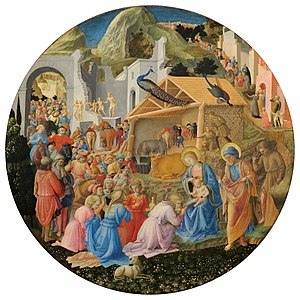
|
Adoration of the Magi is a tondo in tempera on a wood panel, believed to have been painted mostly by Filippo Lippi in the mid-15th century. It depicts the Adoration of the Magi, the Biblical story in which the three Magi present the Christ Child with gifts of gold, frankincense, and myrrh, and worship him. The painting is now in the National Gallery of Art in Washington, D.C. Painting: Filippo Lippi, with contributions by other artists
Recently featured:
|
May 24

|
Hurricane Erika was a weak hurricane that struck extreme northeastern Mexico near the Texas-Tamaulipas border in mid-August of the 2003 Atlantic hurricane season. Initially, Erika was not designated a hurricane by the National Hurricane Center as initial data suggested winds of 70 mph (115 km/h) at peak intensity; only after later analysis was it revised to Category 1 intensity. While Erika's precursor disturbance was moving across Florida, it dropped heavy rainfall. In south Texas, Erika produced moderate winds of 50 to 60 mph (80 to 95 km/h) along with light rain, causing minor and isolated wind damage in the state. In northeastern Mexico, Erika produced moderate rainfall, resulting in mudslides and flooding, and two people were killed when their vehicle was swept away by floodwaters. Photograph: NASA, MODIS/LANCE, HDF File Data processed by Supportstorm
Recently featured:
|
May 25

|
Hendrik Merkus de Kock (1779–1845) was a Dutch general, minister, and senator. In 1821, he commanded a military expedition to Palembang to suppress a local uprising. Later, as Lieutenant Governor-General of the Dutch East Indies, De Kock led the fight against Prince Diponegoro in the Java War (1825–1830), ultimately capturing his opponent through false pretenses at Magelang. For his military victories, de Kock was made baron in 1835, Minister of the Interior in 1836, and Minister of State in 1841. Painting: Cornelis Kruseman
Recently featured:
|
May 26

|
Harvesters is a 1905 oil painting on canvas by the Danish artist Anna Ancher, a member of the artists' community known as the Skagen Painters. Unlike many works of the community, this painting depicts not the fishing activities in Skagen, but a man and two women on their way to start the harvest in the fields. Owing to its depiction of a bountiful harvest and a scythe, the work has been interpreted as juxtaposing life and death. The painting is in the collection of Skagens Museum. Painting: Anna Ancher
Recently featured:
|
May 27
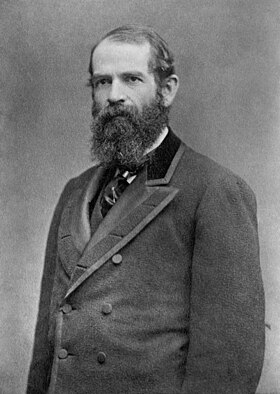
|
Jay Gould (1836–1892) was a leading American railroad developer and speculator. He began acquiring depreciated land in his 20s, and following the Panic of 1857 he became the majority shareholder in the Rutland and Washington Railroad, having acquired stocks for ten cents on the dollar. Over his lifetime, he acquired a fortune conservatively estimated at $72 million ($1.76 billion in 2016). He has been portrayed as a ruthless robber baron of the Gilded Age, hated and reviled. However, some modern historians have used primary sources to combat this portrayal. Photograph: Bain News Service; restoration: Adam Cuerden
Recently featured:
|
May 28
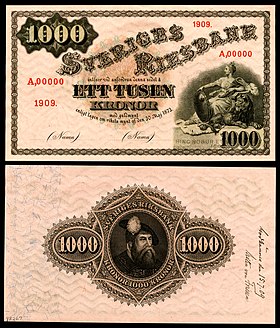
|
The krona is the currency of Sweden. Introduced in 1873 to replace the riksdaler, the currency's first issue included coins in denominations of 1, 2, 5, 10, 25, and 50 öre (where 100 öre = 1 krona) and 1, 2, 10, and 20 kronor. Banknotes were introduced the following year, in denominations of 1 krona and 5, 10, 50, 100, and 1,000 kronor. This 1,000 krona specimen was printed in 1909. The original designs/engravings for this note were introduced in 1888 and remained largely unchanged (aside from denomination) through 1914, including an allegory of Svea by Max Mirowsky on the front and Gustav Vasa on the back. Banknote: Sveriges Riksbank (image courtesy of the National Numismatic Collection, National Museum of American History)
Recently featured:
|
May 29
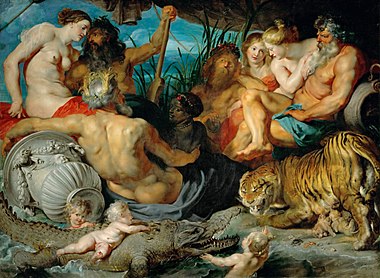
|
The Four Continents is a painting by Flemish artist Peter Paul Rubens made in the 1610s. It is held to depict female personifications of four continents (Europe, Asia, Africa and America) sitting with the personifications of their respective major rivers: the Danube, the Ganges, the Nile and the Río de la Plata. Other interpretations have suggested that these four female figures are nymphs representing the headwaters of four major rivers. The painting is held at the Kunsthistorisches Museum in Vienna. Painting: Peter Paul Rubens
Recently featured:
|
May 30

|
The inland thornbill (Acanthiza apicalis) is an insect-eating bird of Australia. It averages 10 centimetres (3.9 in) in length and 7 grams (0.25 oz) in weight. This small bird lives in dry scrublands and woodlands, as well as the sand heaths and karri and jarrah forests of Southwestern Australia. It feeds on small insects and spiders, and occasionally seeds and small vegetable matter, beneath shrubs and in foliage. Photograph: Peter Jacobs
Recently featured:
|
May 31

|
Frederik Sødring (1809–1862) was a Danish landscape painter and founder of an endowment. He studied under Jens Peter Møller, was influenced by Johan Christian Dahl, and travelled to Norway and Germany to further his craft. By the 1830s, he was exhibiting landscapes from the Rhine, Southern Germany, and Tyrol. This portrait of Sødring was painted by Christen Købke in 1832. It is now part of the Hirschsprung Collection in Copenhagen. Painting: Christen Købke
Recently featured:
|
Picture of the day archives and future dates